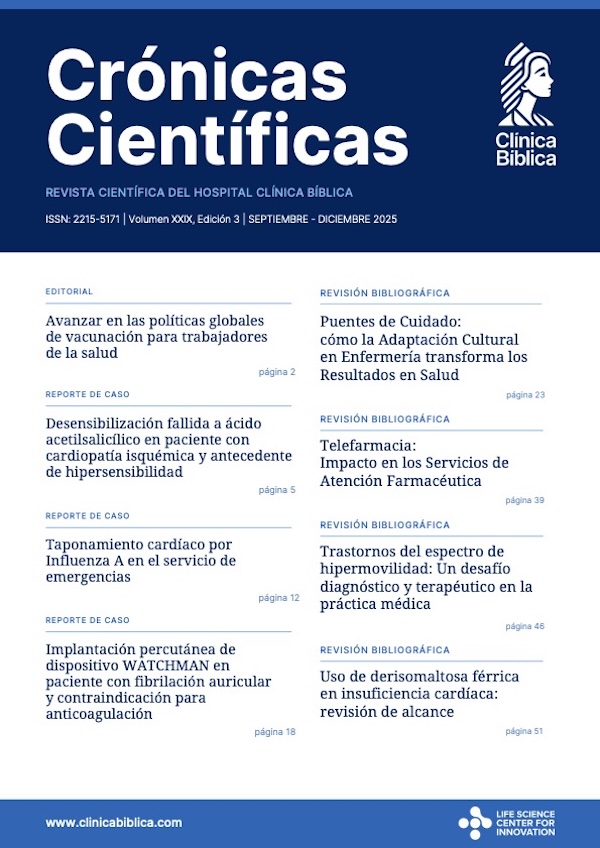- Visto: 1197
Revisión Bibliográfica
Enfermedad por Coronavirus: ¿Qué sabemos hasta hoy?
Coronavirus disease: What we know until today?
Edición XVI Setiembre - Diciembre 2020
DOI: https://doi.org/10.55139/DYNI9035
APA (7ª edición)
Arias Argüello, A. (2020). Enfermedad por Coronavirus: ¿Qué sabemos hasta hoy?. Crónicas científicas, 16(16), 18-39. https://doi.org/10.55139/DYNI9035.
Vancouver
Arias Argüello A. Enfermedad por Coronavirus: ¿Qué sabemos hasta hoy?. Cron cient. 25 de agosto de 2020; 16(16): 18-39.
Dra. Andrea Arias Argüello
Médico y curujano general.
Trabajador Independiente.
Consulta privada, San José, Costa Rica.
Universidad de Ciencias Médicas de Costa Rica.
Miembro del Colegio de Médicos y Cirujanos de Costa Rica
Costa Rica.
Resumen
Si bien en el pasado los coronavirus humanos fueron catalogados como causantes de patologías de características leves, por tercera ocasión, durante el siglo XXI, un coronavirus zoonótico ha cruzado especies para infectar a la población humana. Este último virus, denominado inicialmente coronavirus de Wuhan, 2019 Novel Coronavirus n2019 CoV y, actualmente, SARS-CoV-2 (severe acute respiratory syndrome coronavirus 2) se identificó por primera vez a finales del mes de diciembre del 2019 en la República Popular de China, previo al inicio del Año Nuevo Lunar Chino, el evento anual de viajes en masa más grande del mundo.
El alcance y el efecto final de este virus no está claro en la actualidad, ya que la situación está evolucionando rápidamente.
Las otras dos cepas: el síndrome respiratorio agudo severo asociado a coronavirus (SARS-CoV) y el síndrome respiratorio del Medio Oriente por coronavirus (MERS-CoV), son también de origen zoonótico y se han relacionado con enfermedades en ocasiones asociadas a mortalidad. El SARS-CoV fue el agente causal de los brotes de síndrome respiratorio agudo severo en 2002 y 2003 en la provincia de Guangdong, China. MERS-CoV fue el patógeno responsable de brotes de enfermedades respiratorias graves en 2012 en el Medio Oriente.
Este artículo pretende describir las especies de la familia Coronaviridae que afectan a los humanos, específicamente SARS y MERS; se enfatiza en el SARSCoV- 2, sus características y las lecciones importantes de la pandemia por coronavirus 2019 (COVID-19).
Palabras claves
Coronaviridae, influenza, humana, neumonía, síndrome respiratorio agudo severo.
Abstract
Although in the past human coronaviruses were classified as causing pathologies of mild characteristics, for the third time, during the 21st century, a zoonotic coronavirus has crossed species to infect the human population. The latter virus, recently named Wuhan Coronavirus, 2019 New coronavirus n2019 CoV and currently SARS-CoV-2 (severe acute respiratory syndrome coronavirus 2) was first identified at the end of December 2019 in the People's Republic of China, prior to the start of the Chinese Lunar New Year, the world's largest annual mass travel event.
The scope and final effect of this virus is not clear at present and the situation is evolving rapidly. he other two strains: the severe acute respiratory syndrome associated with coronavirus (SARS-CoV) and the coronavirus of the Middle East respiratory syndrome (MERS-CoV), are also of zoonotic origin and have been linked to diseases in patients affected by mortality. SARS-CoV was the causative agent of severe acute respiratory syndrome outbreaks in 2002 and 2003 in Guangdong Province, China. MERSCoV was the pathogen responsible for severe respiratory disease outbreaks in 2012 in the Middle East.
This article aims to describe the species of the Coronaviridae Family that affect humans specifically SARS, MERS, Experiment an emphasis on SARS-CoV-2, its characteristics and important lessons of the pandemic coronavirus disease 2019 (COVID-19).
Keywords
Coronaviridae, influenza, human, pneumonia, severe acute respiratory syndrome.
Bibliografía
Alhazzani, W., Møller, M.H., Arabi, Y.M., Loeb, M., Ng M., Fan, E., Oczkowski, S., Levy, M., Derde, L., Dzierba, A., Du, B., Aboodi, M., Wunsch, H., Cecconi, M., Koh, Y., Chertow, D., Maitland, K., Belley, E., Greco, M., McGeer, A., Alexander, P., Arrington, A., Citerio, G., Evans, L., Rhodes, A. (2020). Surviving Sepsis Campaign: guidelines on the management of critically ill adults with coronavirus disease 2019 (COVID-19). Intensive Care Medicine 46, 854-887.
Arabi, Y.M., Mandourah, Y., Al-Hameed, F. Sindi, a., Almeklafi G., Hussein, M., Pinto, R., Al-Omari, A., Kharaba, A., Shalhoub, S., Mady, A., Qushmaq, I., Solaiman, O., Al-Raddadi, R., Al Harty, A., Deeb, A., Al Mutairi, H., Hayden, F., Fowler, R. (2018). Corticosteroid therapy for critically ill patients with Middle East Respiratory Syndrome. American Journal of Respiratory and Critical Care Medicine, 197, 757-767.
Berlin, D.A., Gulick, R.M., Martínez, F. (2020). Severe Covid-19.The New England Journal of Medicine. doi: 10.1056/NEJMcp2009575
Bhatraju, P.K., Ghassemieh, B.J., Nichols, M., Richard, K., Jerome, K., Greninger, A., Pipavath, S., Wurfel, M, Evans, L., Kritek, L., West, E., Luks, A., Gerbino, A., Dale, C., Goldman, J., O´Mahony, S., Mikacenic, C.. Covid-19 in critically ill patients in the Seattle region—case series. The New England Journal of Medicine. doi: 10.1056/NEJMoa2004500.
Bhimraj, A., Morgan, R.L., Hirsch Shumaker, A., Lavergne, V., Baden, L., Chi-Chung Cheng, V., Edwards, K.M., Gandhi, R., Muller, W.J., O’Horo, J.C., Shoham, S. y Murad, H. (2020). Infectious Diseases Society of America guidelines on the treatment and management of patients with COVID-19. Arlington, VA: Infectious Diseases Society of America.
Borba, M.G.S., Val, F.F.A., Sampaio, V.S., Cardoso Melo, G., Brito, M., BNrito-Sousa, J.D., Baía-da-Silva, D., Costa Pinto, R., Fonseca Pacheco, A., Oliveira Santos Jr, J.D., Croda, J., Sierra Romero, G., Bassat, Q., Guimaraes Lacerda, M.V. (2020). Effect of high vs low doses of chloroquine diphosphate as adjunctive therapy for patients hospitalized with severe acute respiratory syndrome coronavirus 2 (SARS-CoV-2) infection: a randomized clinical trial. The Journal of the American Medical Association 3(4), e208857-e208857.
Cao, B., Wang, Y., Wen, D., Hu, J., Ruan, S., Gong, F., Shang, L., Wu, X., Zhang, D., Wang, C. (2020). A trial of lopinavir–ritonavir in adults hospitalized with severe Covid-19. The Journal of the American Medical Association 382, 1787-1799.
Centers for Disease Control and Prevention. (2020). Interim clinical guidance for management of patients with confirmed coronavirus disease (COVID-19). Recuperado de https://www.cdc.gov/coronavirus/2019-ncov/hcp/clinical-guidance-management-patients.html
Chan, J.F-W, Yuan, S., Kok, K.-H., Yang, J., Chu, H., Liu, J. (2020). A familial cluster of pneumonia associated with the 2019 novel coronavirus indicating person-to-person transmission: a study of a family cluster. Lancet, S0140-6736(20), 30154-9. doi:10.1016/S0140-6736(20)30154-9.
Chen, N., Zhou, M.,Qu, J., Gong, F., Dong, X., Hang, Y. (2020). Epidemiological and clinical characteristics of 99 cases of 2019 novel coronavirus pneumonia in Wuhan, China: a descriptive study. Lancet. doi:10.1016/S0140-6736(20)30211-7.
Chen, J., Liu, D., Liu, L. Xu, Q., Xia, L., Ling, Y., Huang, D. (2020). A pilot study of hydroxychloroquine in treatment of patients with common coronavirus disease-19 (COVID-19). Journal of the Zhejiang University Medical Sciences.
Chen, Z., Hu, J., Zhang, Z., Jiang, S., Yan, D.(2020). Efficacy of hydroxychloroquine in patients with COVID-19: results of a randomized clinical trial. Recuperado de https://www.medrxiv.org/content/10.1101/2020.03.22.20040758v3
Chih-Cheng, L., Tzu-Ping, Sh., Wen-Chien, K., Hung-Jen, T. y Po-Ren, H. (2020) Severe acute respiratory syndrome coronavirus 2 (SARS-CoV-2) and coronavirus disease-2019 (COVID-19): The epidemic and the challenges. International Journal of Antimicrobial Agents, doi: 10.1016/j.ijantimicag.2020.105924
Chowell, G., Abdirizak, F., Lee, S., Lee, J., Jung, E., (2015). Transmission characteristics of MERS and SARS in the healthcare setting: a comparative study. Biomed Central, doi: 10.1186/s12916-015-0450-0
Choy, K-T, Wong, A.Y., Kaewpreedee, P., Hui-Ling, Y. (2020). Remdesivir, lopinavir, emetine, and homoharringtononine inhibit SARS-CoV-2 replication in vitro. Antiviral Research Journal.
Cook, T.M., El-Boghdadly, K., McGuire, B., McNarry, A.F., Patel, A. y Higgs, A. (2020). Consensus guidelines for managing the airway in patients with COVID-19: guidelines from the Difficult Airway Society, the Association of Anaesthetists the Intensive Care Society, the Faculty of Intensive Care Medicine and the Royal College of Anaesthetists. Anaesthesia, 75, 785-799. doi: 10.1111/anae.15054
de Wilde, A.H., Snijder, E.J., Kikkert, M. y van Hemert, M.J. (2018). Host factors in coronavirus replication. Current Topics in Microbiology and Immunology, 419, 1-42. doi:10.1007/82_2017_25
de Wit, E., van Doremalen, N., Falzarano, D. y Munster, V.J. (2016). SARS and MERS: recent insights into emerging coronaviruses. Nature Review Microbiology, 14(8), 523-534. doi:10.1038/nrmicro.2016.81
Ding, L., Wang, L., Ma, W. y He, H. (2020). Efficacy and safety of early prone positioning combined with HFNC or NIV in moderate to severe ARDS: a multi-center prospective cohort study. Critical Care, 24, 28-28.
Duan, K., Liu, B., Li, C., Dang, X.,l. (2020). Effectiveness of convalescent plasma therapy in severe COVID-19 patients. Proceedings of the National Academy of Sciences of the United States of America, 117, 9490-9496.
Gattinoni, L., Coppola, S., Cressoni, M., Busana, M., Rossi, S. y Chiumello, D. (2020). Covid-19 does not lead to a “typical” acute respiratory distress syndrome. American Journal of Respiratory and Critical Care Medicine, 30 Apr 2020, 201(10):1299-1300
Gautret, P., Lagier, J.-C., Parola, P., La Scola, B., Raoult, D. (2020). Hydroxychloroquine and azithromycin as a treatment of COVID-19: results of an open-label non-randomized clinical trial. International Journal of Antimicrobial Agents.
Goyal P, Choi JJ, Pinheiro L.C.. Martinez, F., Safo, M.Clinical characteristics of Covid-19 in New York City. The New England Journal of Medicine. DOI: 10.1056/NEJMc2010419.
Graham, B.S., Mascola, J.R. y Fauci, A.S. (2018). Novel vaccine technologies: essential components of an adequate response to emerging viral diseases. The Journal of the American Medicine Association, 319(14), 1431-1432. Doi: 10.1001/jama.2018.0345
Grasselli, G., Zangrillo, A., Zanella, A.,Cecconi, M., Storti, E., . (2020). Baseline characteristics and outcomes of 1591 patients infected with SARS-CoV-2 admitted to ICUs of the Lombardy region, Italy. The Journal of the American Medicine Association323,1574-1581.
Grein, J., Ohmagari, N., Shin, D., Nicastri E., Oda, R. Compassionate use of remdesivir for patients with severe Covid-19. 2020. The New England Journal of Medicine. DOI: 10.1056/NEJMoa2007016.
Guan, W., Ni, Z., Hu, Y., Lui, L.(2020). Clinical characteristics of coronavirus disease 2019 in China. The New England Journal of Medicine, 382, 1708-1720.
Guo, T., Fan, Y., Chen, M., Lu, Z. (2020). Cardiovascular implications of fatal outcomes of patients with coronavirus disease 2019 (COVID-19). Journal of the American Medical Association Cardiology.
Helms, J., Tacquard, C., Severac, F. et al. (2020). High risk of thrombosis in patients with severe SARS-CoV-2 infection: a multicenter prospective cohort study. Intensive Care Medicine.
Holshue, M.L., DeBolt, C., Lindquist, S., Meziani, F. (2020). Washington State 2019-nCoV Case Investigation Team. First case of 2019 novel coronavirus in the United States. The New England Journal of Medicine. doi:10.1056/NEJMoa2001191
https://www.ministeriodesalud.go.cr https://www.ministeriodesalud.go.cr/ https://www.who.int/es/dg/speeches/detail/who-director-general-s-opening-remarks-at-the-media-briefing-on-covid-19---11-march-2020
Huang, C., Liu, M.,Guo, L. (2020). Clinical feature of patients infected with 2019 novel coronavirus in Wuhan, China. Lancet. doi:10.1016/S0140-6736(20)30183-5
Huang, M., Tang, T., Pang, P. Shu, J., Liang, J. (2020). Treating COVID-19 with chloroquine. Journal of Molecular Cell Biology. doi.org/10.1093/jmcb/mjaa014
Hui, D.S., I Azhar, E, Madani, T.A., Ippolito, G.(2020). The continuing 2019-nCoV epidemic threat of novel coronaviruses to global health: the latest 2019 novel coronavirus outbreak in Wuhan, China. International Journal of Infectious Diseases, 91, 264-266. doi:10.1016/j.ijid.2020.01.009
Junqiang Lei, Junfeng Li, Xun Li, Xiaolong Qi. (2020) CT Imaging of the 2019 Novel Coronavirus (2019-nCoV) Pneumonia. Radiology, 200236.
Klok, F.A., Kruip, M.J.H.A., van der Meer, N.J., Huisman, M.. (2020). Incidence of thrombotic complications in critically ill ICU patients with COVID-19. Thrombosis Research. DOI:https://doi.org/10.1016/j.thromres.2020.04.013
Leung, N.H.L., Chu, D.K.W., Shiu, E.Y.C. (2020). Respiratory virus shedding in exhaled breath and efficacy of face masks. Nature Medicine. 26, pages676–680(2020)
Li, Q., Guan, X., Wu, P. (2020). Early transmission dynamics in Wuhan, China, of novel coronavirus-infected pneumonia. The New England Journal of Medicine.
Liu, J., Cao, R., Xu, M. (2020). Hydroxychloroquine, a less toxic derivative of chloroquine, is effective in inhibiting SARS-CoV-2 infection in vitro. Cell Discovery, 6, 16-16.
Lu, H., Stratton, C.W. y Tang, Y.W. (2020). Outbreak of pneumonia of unknown etiology in Wuhan China: the mystery and the miracle. Journal of Medical Virologyl. doi:10.1002/jmv.25678
Magagnoli, J., Narendran, S., Pereira, F. (2020). Outcomes of hydroxychloroquine usage in United States veterans hospitalized with Covid-19. Recuperado de https://www.medrxiv.org/content/10.1101/2020.04.16.20065920v2
Mao, L., Jin, H., Wang, M. (2020). Neurologic manifestations of hospitalized patients with coronavirus disease 2019 in Wuhan, China. The Journal of American Medical Association Neuroogyl.
Bassetti, M., Vena, A. y Giacobbe, D. R. (2020) The novel Chinese coronavirus (2019‐nCoV) infections: Challenges for fighting the storm. European Journal of Clinical Investigation, doi.org/10.1111/eci.13209
Matthay, M.A., Aldrich, J.M. y Gotts, J.E. (2020). Treatment for severe acute respiratory distress syndrome from COVID-19. Lancet Respiratory Medicine, 8, 433-434.
Mehta, P., McAuley, D.F., Brown, M., Sánchez, E., Tattersall, R.S. y Manson, J.J. (2020). COVID-19: consider cytokine storm syndromes and immunosuppression. Lancet, 395, 1033-1034.
Ñamendys-Silva, S.A. (2020). Respiratory support for patients with COVID-19 infection. Lancet Respiratory Medicine, 8(4), e18-e18.
National Institutes of Health. (2020). NIH trial shows remdesivir accelerates recovery from advanced COVID-19. Recuperado de https://www.nih.gov/news-events/news-releases/nih-clinical-trial-shows-remdesivir-accelerates-recovery-advanced-covid-19
Paules, C.I., Marston, H.D. y Fauci, A.S. (2020). Coronavirus infections—more than just the common cold. The Journal American Medical Association. doi:10.1001/jama.2020.0757
Phelan, A.L., Katz, R. y Gostin, L.O. (2020). The novel coronavirus originating in Wuhan, China: challenges for global health governance. The Journal of the American Medical Association. doi:10.1001/jama.2020.1097
Ping-Ing, L. y Po-Ren, H. (2020). Emerging threats from zoonotic coronaviruses-from SARS and MERS to 2019-nCoV. Journal of Microbiology, Immunology and Infection.
Poston, J.T., Patel, B.K. y Davis, A. M. (2020). Management of critically ill adults with COVID-19. The Journal of the American Medical Association.
Richardson, S., Hirsch, J.S., Narasimhan. (2020). Presenting characteristics, comorbidities, and outcomes among 5700 patients hospitalized with COVID-19 in the New York City area. The Journal of the American Medical Association. doi:10.1001/jama.2020.6775
Russell, C.D., Millar, J.E. y Baillie, J.K. (2020). Clinical evidence does not support corticosteroid treatment for 2019-nCoV lung injury. Lancet, 395, 473-475.
Sheahan, T.P., Sims, A.C., Leist, S.R. (2020). Comparative therapeutic efficacy of remdesivir and combination lopinavir, ritonavir, and interferon beta against MERS-CoV. Nature Communications, 11(1), 222. doi:10.1038/s41467-019-13940-6
Shen, C., Wang, Z., Zhao, F.. (2020). Treatment of 5 critically ill patients with COVID-19 with convalescent plasma. The Journal of the American Medical Association, 323, 1582-1589.
Song, Z., Xu, Y., Bao, L. (2019). From SARS to MERS, thrusting coronaviruses into the spotlight. Viruses, 11(1), 11. doi:10.3390/v11010059
Sun, Q., Qiu, H., Huang, M. y Yang, Y. (2020). Lower mortality of COVID-19 by early recognition and intervention: experience from Jiangsu Province. Annals of Intensive Care, 10, 33-33.
Tang, N., Bai, H., Chen, X., Gong, J., Li, D. y Sun, Z. (2020). Anticoagulant treatment is associated with decreased mortality in severe coronavirus disease 2019 patients with coagulopathy. Journal Thrombosis and Haemostasis, 18, 1094-1099.
Tang, N., Li, D., Wang, X. y Sun, Z. (2020). Abnormal coagulation parameters are associated with poor prognosis in patients with novel coronavirus pneumonia. Journal of Thrombosis and Haemostasis, 18, 844-847.
Tran, K., Cimon, K., Severn, M., Pessoa-Silva, C.L. y Conly, J. (2012). Aerosol generating procedures and risk of transmission of acute respiratory infections to healthcare workers: a systematic review. PLoS One, 7(4), e35797-e35797.
Wan, S., Xiang, Y., Fang, W. et al. (2020). Clinical features and treatment of COVID-19 patients in northeast Chongqing. Journal of Medical Virology.
Wang, D., Hu, B., Hu, C. (2020). Clinical characteristics of 138 hospitalized patients with 2019 novel coronavirus-infected pneumonia in Wuhan, China. The Journal of the American Medical Association, 323, 1061-1069.
Wang, M., Cao, R., Zhang, L. (2020). Remdesivir and chloroquine effectively inhibit the recently emerged novel coronavirus (2019-nCoV) in vitro. Cell Research, 30, 269-271.
Wang, Y., Zhang, D., Guanhua, D. et al. (2020). Remdesivir in adults with severe Covid-19: a randomized, double-blind, placebo-controlled, multicentre trial. Lancet. Recuperado de https://www.thelancet.com/pdfs/journals/lancet/PIIS0140-6736(20)31022-9.pdf
Wilson, K.C., Chotirmall, S.H., Bai, C. y Rello, J. (2020). Covid-19: Interim guidance on management pending empirical evidence: from an American Thoracic Society-led international task force.
Wu, J.T., Leung, K. y Leung, G.M. (2020). Nowcasting and forecasting the potential domestic and international spread of the 2019-nCoV outbreak originating in Wuhan, China: a modelling study. Lancet. doi:10.1016/S0140-6736(20)30260-9
Wu, C., Chen, X., Cai, Y. (2020). Risk factors associated with acute respiratory distress syndrome and death in patients with coronavirus disease 2019 pneumonia in Wuhan, China. The Journal of the American Medical Association Internal Medicine.
Wu, Z. y McGoogan, J.M. (2020). Characteristics of and important lessons from the coronavirus disease 2019 (COVID-19) outbreak in China: summary of a report of 72 314 cases from the Chinese Center for Disease Control and Prevention. The Journal of the American Medical Association Internal Medicine.
Wu, Gamber y Sun. (2020). Does Wuhan Need to be in Lockdown during the Chinese Lunar New Year? International Journal of Environmental Research and Public Health, 17(3), 1002.
Yi, Zhang, Jiuyang Xu, Hui Li y Bin Cao. (2020). A Novel Coronavirus (COVID-19) Outbreak. Chest. Yu, I.T., Li, Y., Wong, T.W. (2004). Evidence of airborne transmission of the severe acute respiratory syndrome virus. The New England Journal of Medicine, 350(17), 1731-1739. doi:10.1056/NEJMoa032867
Zhou, F., Yu, T., Du, R. (2020). Clinical course and risk factors for mortality of adult inpatients with COVID-19 in Wuhan, China: a retrospective cohort study. Lancet, 395, 1054-1062.
Zhu, N., Zhang, D., Wang, W. et al. (2020). China Novel Coronavirus Investigating and Research Team. A novel coronavirus from patients with pneumonia in China, 2019. The New England Journal of Medicine. doi:10.1056/NEJMoa2001017
Ziehr, D.R., Alladina, J., Petri, C.R. (2020). Respiratory pathophysiology of mechanically ventilated patients with COVID-19: a cohort study. American Journal of Respiratory and Criticical Care Medicine.
APA (7ª edición)
Arias Argüello, A. (2020). Enfermedad por Coronavirus: ¿Qué sabemos hasta hoy?. Crónicas científicas, 16(16), 18-39. https://doi.org/10.55139/DYNI9035.
Vancouver
Arias Argüello A. Enfermedad por Coronavirus: ¿Qué sabemos hasta hoy?. Cron cient. 25 de agosto de 2020; 16(16): 18-39.
Esta obra está bajo una licencia internacional Creative Commons: Atribución-NoComercial-CompartirIgual 4.0 Internacional (CC BY-NC-SA 4.0)

Realizar búsqueda
Última Edición
Ediciones Anteriores






